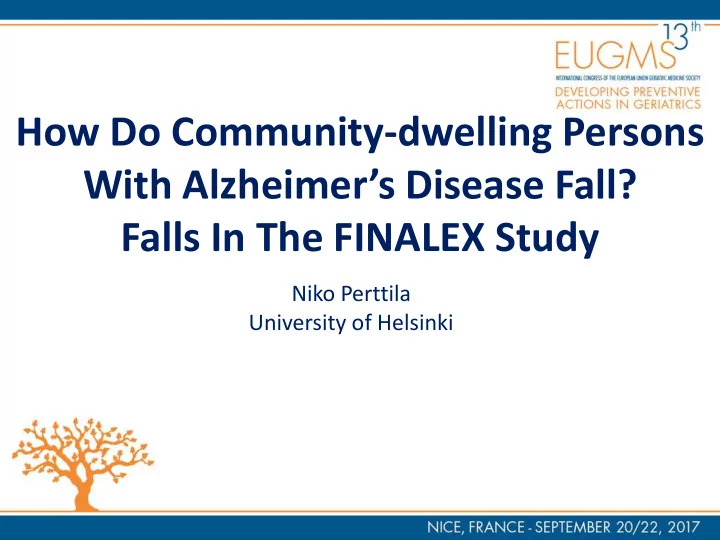

How Do Community-dwelling Persons With Alzheimer’s Disease Fall? Falls In The FINALEX Study Niko Perttila University of Helsinki
CONFLICT OF INTEREST DISCLOSURE I have no potential conflict of interest to report
Falls and dementia • 60 % of people with dementia fall annually • Few studies have investigated falls among participants with dementia
Aim and introduction • To investigate how community-dwelling persons with Alzheimer’s disease (AD) fall – When? Why? How? Consequences? • FINALEX study was 1-year RCT exercise intervention study among AD patients – Home-based/group-based exercise (N=129) 2x/wk – Controls: normal community care (N=65)
Methods • Participants in the FINALEX study: – Alzheimer Disease – An ability to walk independently with/without mobility aid – Sign of frailty: • ≥1 fall / previous 12 months OR • unintentional weight loss OR • slow gait speed Pitkala et al. JAMA Intern Med. 2013 ;173:894-901.
Methods • Participants’ (N=194) falls were followed up for one year by diaries kept by their spouses. • Groups formed for participants with 0 (N=103), 1 (N=34) and ≥2 (N=57) falls • We investigated various features and risk factors behind the falls.
Results: Falls: when, why, consequences • Altogether 355 falls: • Half of them at midday, rest equally during morning, evening, and night time • The most common reasons for falls were stumbling (N=61), dizziness (N=37), and weakness of legs (N=18) • In most cases, the spouses were unable to state the reason for falling • Of 355 falls, 123 led to injuries, 50 to emergency department visits, and 13 to fractures
Results: Associated baseline risk factors for falls ≥2 falls 0 falls 1 fall P for N=103 N=34 N=57 linearity* Age, mean (SD) 77 (5) 78 (6) 80 (4) 0.003 MNA, mean (SD) 23 (2) 23 (1) 22 (3) 0.037 Blood pressure, systolic 153 (24) 154 (28) 143 (27) 0.016 CDR, n (%) <0.001 0.5-1 44 (43) 12 (35) 10 (18) 2 47 (46) 17 (50) 31 (54) 3 12 (12) 5 (15) 16 (28) FIM total, mean (SD) 92.6 (17.3) 92.0 (14.0) 77.2 (18.6) <0.001 SPPB total, mean (SD) 10.2 (2.1) 9.7 (1.8) 8.7 (2.4) <0.001 Vision problem, n (%) 6 (6) 2 (6) 9 (16) 0.042 Fall history, n (%) 32 (31) 38 (24) 35 (61) <0.001 SD = standard deviation; MNA = Mini Nutritional Assessment; CDR = Clinical Dementia Rating scale; FIM = Functional Independence Measure; SPPB = Short Physical Performance Battery No significant difference: Intervention, gender, education, BMI, Diastolic blood pressure, Charlson comorbidity index Perttila et al. Dement Geriatr Cogn Dis Extra 2017 Jun 19;7(2):195-203.
Results: MMSE / polypharmacy vs. falls Incidence of falls per person years Incidence of falls per person years A B 3,0 3,0 Incidence of falls per person years 2,5 Incidence of falls per person years 2,5 2,0 2,0 1,5 1,5 1,0 1,0 0,5 0,5 0,0 0,0 0 5 10 15 20 25 30 2 4 6 8 10 12 14 16 18 20 Number of drugs Mini Mental State Examination score MMSE Number of drugs Perttila et al. Dement Geriatr Cogn Dis Extra 2017 Jun 19;7(2):195-203.
A MNA Balance Walking speed Up&Go Falls: SPPB FIM mot 0,2 0,3 0,4 0,5 0,6 0,7 0,8 0,9 1,0 1,1 1,2 Protective IRR (per 1-SD) B Cancer and risk Hypertension Stroke Myocardial infarction factors for COPD Claudication CHD falls DM Heart failure Osteoarthritis 0,5 1,0 1,5 2,0 2,5 3,0 3,5 4,0 4,5 5,0 IRR C Antihypertensive Anticholinergic drug Psychotropic Opioid 0,5 1,0 1,5 2,0 2,5 3,0 3,5 4,0 4,5 5,0 5,5 6,0 6,5 7,0 Perttila et al. Dement Geriatr Cogn Dis Extra 2017 Jun 19;7(2):195-203. IRR
Strenghts • Participants had confirmed diagnosis of Alzheimer’s Disease • Diary is the best method to accurately record falls • Prospective and detailed follow-up
Limitations • The participants were motivated caucasians living at home with their spouses - generalization? • The number of participants was small • Intervention reduced the number of falls – the number of falls is underestimate of real life – modifying falls also?
Conclusions • Alzheimer’s Disease patients have increased fall risk • Polypharmacy, anticholinergic drugs, psychotropics, and opioids increase the fall risk – confounding by indication? • Individuals with MMSE ~10 are at greatest risk • COPD, diabetes, osteoarthritis increase fall risk • Good physical functioning protects against falls • In this study hypertension and antihypertensive medication were protective factors – mechanism?
Co-workers: Hanna Öhman Timo Strandberg Hannu Kautiainen Minna Raivio Marja-Liisa Laakkonen Nina Savikko Reijo Tilvis Kaisu Pitkala This study was supported by: the Social Insurance Institution of Finland, the Central Union for the Welfare of the Aged, the Sohlberg Foundation, King Gustaf V and Queen Victoria’s Foundation , Paulo Foundation, The Finnish Medical Foundation, The Finnish Association for General Practice, Finnish foundation Avohoidon tutkimussäätiö, University of Helsinki chancellor's travel grant Thank you! Merci!
Recommend
More recommend